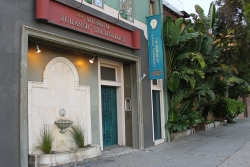There’s no way for me to start except to say that the Jurassic Museum of Technology is one of the weirdest museum adventures I’ve ever had.
In my experience, museums exist A) to make education fun, hands on, and inspiring, or B) they finish up a unit of study and you finally see what you’ve been reading about come alive. The Jurassic Museum of Technology does something mysteriously in between.
If you’ve haven’t heard of the Museum, that’s probably because it’s hidden in plain view—a block east of the In-N-Out on Venice. It’s a small museum, street parking only, and there are no windows to see what lurks inside—often described as “offbeat” and “unassuming.”
Closed Monday through Wednesday, a passerby might imagine that the building might be completely abandoned. Half of the week it’s closed, and the other half it’s, for the most part, dark and quiet.
It sounds like an adventure—and not like the regular educational adventure, like a real life dangerous experience. And once you go inside, there’s no turning back without a proper visit; you immediately enter into the small, dimly lit reception/lobby/store where you’ll encounter—wait for it—half a dozen chatty twenty-somethings who have just been passed by another half dozen twenty-somethings who are wandering the museum. It wasn’t quite what I expected.
I admit that I presupposed that two or three depressed and lonely elderly folks would greet me, and that one of them would be stern and the other would be very cheery and say something like, “It’s so nice to have guests!” and they’d serve me tea and cookies.
But I was wrong. At least, mostly wrong. There is tea and cookies served in the Tula Tearoom on the second floor—for free—and they’re delicious. And the seating area is adorable. But we’ll get there later.
Past the entrance, it was dark. The only lighting is not for the halls, but for the items exhibited. Through the thin walls you’ll hear the soft spoken conversations of your fellow young adventurers and the murmurs of the electronic audio tours of the describing the exhibits—most of which are run through old hand handheld landline phones that weigh almost two pound a piece.
I’ve neglected to describe the exhibits themselves, in part because getting inside is the difficult part. The collection of the museum so scattered that each visitor will just have to find his own interest in whatever it is that catches his attention.
As for myself, I learned about the Geoffrey Sonnabend’s theory of forgetting, Renaissance and Baroque theatre mechanics, the beautiful and delicious custom of eating madeleines, and Soviet space dogs. There is something—at least one thing—for everybody.
If not, there is at least tea and cookies and the garden roof. A pair of the most beautiful and peaceful birds I’ve ever seen in my life are sitting in a columbarium in the corner of the garden.
There doesn’t seem to be much Jurassic technology—and no matter how much there is, it’s unlikely we’ll ever need to study it hands on or be inspired to write a meaningful report on it—it’d still be a shame if all the museum’s old, interesting trinkets and recorded lectures were abandoned or trashed.
The museum still accomplishes what it defines as the original meaning of museum used to be, “a place where man’s mind could attain a mood of aloofness above everyday affairs”—whether through tea gardens or the study of space dogs.













